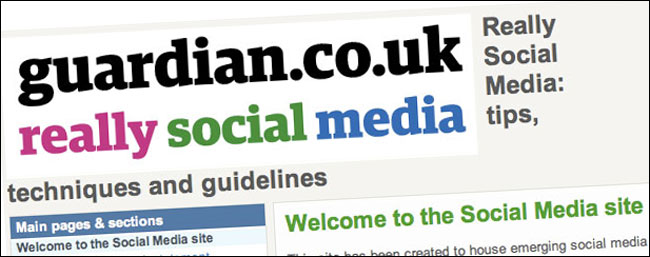Taking a holistic approach to designing & managing communities online
Yesterday I published a blog post sparked by a question after a talk I gave at the BBC World Service the other week, which was: "Do you think journalists should always read the comments underneath their articles?"
The topic of comments on news sites has raised its head more broadly recently, after Boris Johnson wrote that the bashing some journalists get in online comments is good for them. On guardian.co.uk, Comment is free, where the community interaction can certainly be robust, had an open thread debating what he said. NPR recently came out with a case study that suggested they got far more engaged audience interaction on their Facebook page than they did on their own site, and Jeff Pearlman has written for CNN about tracking down his 'online haters'.
One thing that seems obvious to me is this - news organisations need to have clear community management strategies if they want to have engaged communities on their sites. Previously, at the BBC, I worked with 'hosts' on the messagesboards - and sometimes acted as one - who were there to help keep threads on topic, answer questions, welcome newcomers, and tut-tut at and gently discourage bad behaviour. Doug was an exceptional example.
At the Guardian we are open about the participation guidelines for our journalists and staff, and we have 'community co-ordinators' in some areas, encouraging and highlighting the best interaction with the audience. It is a relatively scarce role in news organisations, where the ratio of content creators to community engagers is usually heavily skewed towards the former, in a way that simply wouldn't be the case if you were setting up a start-up that anticipated that kind of volume of commenting.
It isn't just about interacting with users though, but also about encouraging best practice amongst staff who might be unfamiliar with entering into the dialogue that happens underneath their writing. Within the Guardian they are aided by our 'really social media' intranet site, put together by Meg Pickard to encourage best practice.

People aren't the only answer, as technology and user experience design also has a role to play. Packing features onto a community platform is fine, if the features are being used to encourage the kind of behaviour you want to see on your site. Complex systems of rating comments can discourage participation and stifle the voices of new users who do arrive, whilst any system that promises rewards to users risks being gamed.
Slashdot and Stack Overflow are often held up as poster children of really good community platforms, but this ignores the crucial fact that the audiences of both tend to be super-users of the web, meaning that the sites utilise design patterns that the broad audience of a mainstream news site are unlikely to have encountered before.

The Stack Overflow community interface is brilliant for the tech-savvy audience it serves
User experience plays a significant "nudge" role in how people interact on news sites. A large text input box encourages longer comments. A visible character count, especially if it is quite a small limit, can focus a contributor. Threaded replies can encourage chit-chat, whilst strings of comments with no inter-connectivity encourages "drive-by" commenting, where opinion is expressed as a one-off without referring to the rest of the discussion. Systems that show "the most thumbed up" or "recommended" as a default view encourage a winner-takes-all approach, where the comment that garners the most recognition early on in a thread becomes the most visible, and so garners more recognition.
Getting decent audience interaction on news sites requires a holistic approach to community, with all parts of the business involved. Whether it is the technology used, the user experience implemented, the way that journalists and columnists frame debate in their pieces, or the way that comments are moderated and engaged with, all these elements shape the community that you develop.
“currybetdotnet: Best of the blog 2011” brings together over 50 of the best posts on this blog from 2011, covering topics such as live blogging, community and social media for news websites, and the future of digital media. It features write-ups of talks by Guardian journalists including Paul Lewis, Matthew Wells, Andrew Sparrow and Chris Elliot, and behind the scenes looks at Guardian products like the Facebook and iPad apps. It also has transcripts of Martin Belam's talks at EuroIA, the UPA conference, Polish IA Summit, Content Strategy Forum 2011, FutureEverything and Hacks/Hackers London.
“currybetdotnet: Best of the blog 2011” for Kindle is £1.92.

As a reader, it really is a thrill to have a dialogue on an issue you care about with someone who's important enough to be paid to write about the topic. I think a news organization and individual journalists would benefit from creating a relationship like that with their readers. Ignoring the readers for the last several decades is probably one of the reason newspapers are in so much trouble now.
For over a year I have been managing a website for a client that involved me interacting with and commenting on various news stories related to the same industry as the clients.
In all that time after reviewing 1000's of stories I can count on one hand how many times a news reporter commented and interacted with commenter's. In the journalists defense many of the comments were fairly remedial, snarky and rude, but every once in a while there would be some legitimate comments (mine included - I would like to think). And still not a peep out of the journalist who wrote the article.
It would make sense from the business side of the source paper to encourage interaction with reporters which increases viewership. But alas, the "high and mighty" traditional journalistic attitude of informational superiority may actually be what is preventing them from interacting.
I have read stories where the comment section contained more factual and accurate information about the story written by people on the scene or who were involved. These people stepping forward are a wealth of info for the reporters, but (it seems to me) rarely does the story change and give credit to sourced commenters.